Ecdysozoans include nematodes, the most numerous animals, and arthropods, the most diverse.
The second major group of protostome animals is the Ecdysozoa (Fig. 44.20), which get their name from the process of ecdysis, or molting. Uniquely among animals, all ecdysozoans secrete a protein-
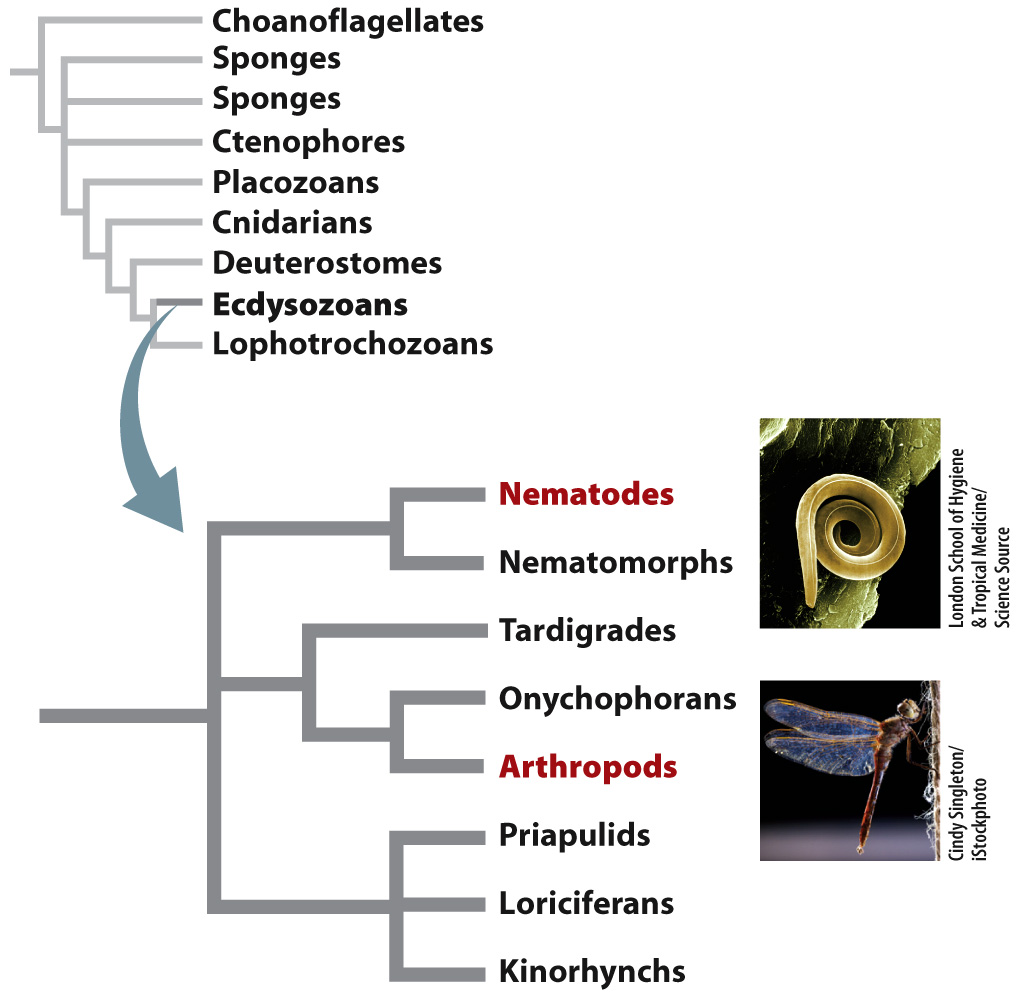
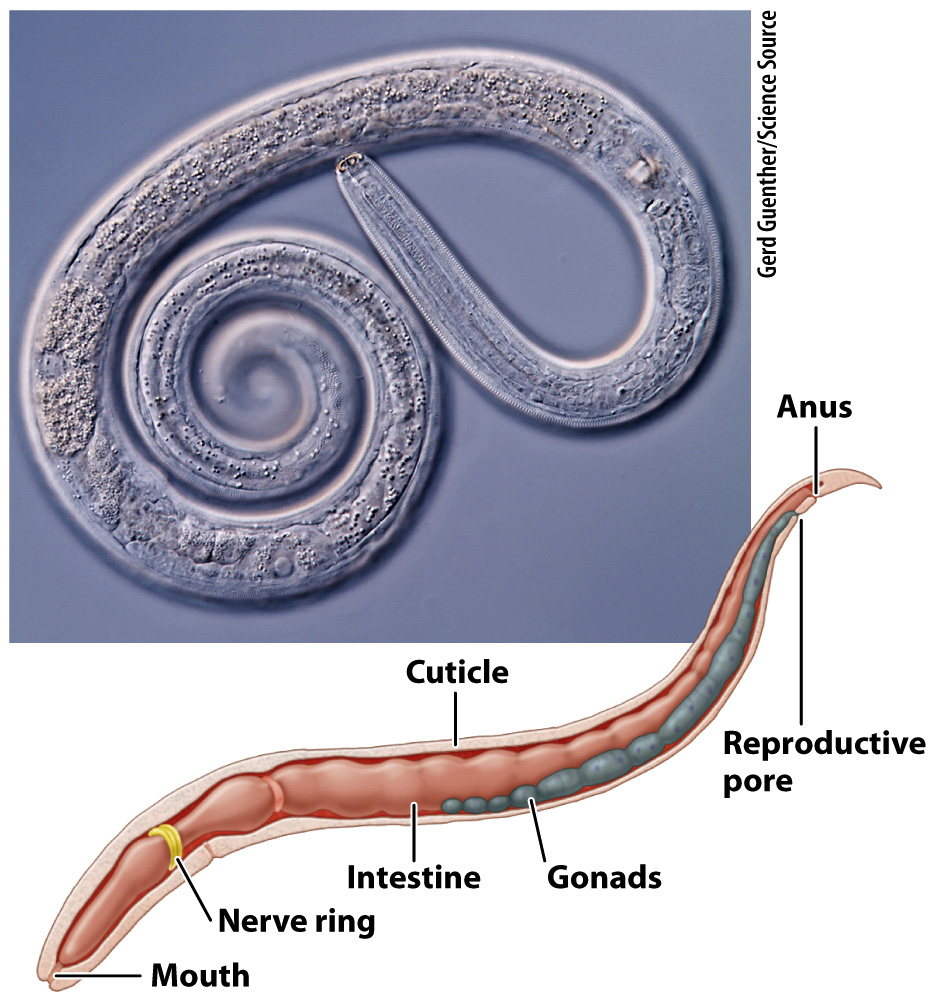
The Ecdysozoa include eight phyla, but two dwarf the others in abundance and diversity. The most numerous of all animals are the small roundworms known as nematodes (Fig. 44.21). Most nematodes are tiny and so you’ve probably never noticed them, but they occur by the billions all around you and may well be inside your body as you read this. About 20,000 nematode species have been described, but estimates of their true diversity run as high as half a million. Most are microscopic, preying on microorganisms in soils and marine sediments. Their elongate cylindrical bodies have a mouth at one end, an intestine for digestion, and an anus in the rear. Other organs are simple: Nerve cords extend along the main axis from a ring in back of the mouth, rudimentary muscles line the body, and gonads expel sperm and eggs for reproduction. Nematodes are the main pseudocoelomate phylum, their digestive and reproductive organs surrounded by a fluid-
If nematodes are the most numerous animals, the Arthropoda, including insects, are the most diverse, accounting for more than half of all known animal species. What features have led to the remarkable evolutionary success of this branch?
Perhaps the most obvious feature of arthropods is the one for which they are named: jointed legs (arthro means “jointed,” and pod means “foot” or “leg”). The jointed leg is the most versatile part of the arthropod body; it has been modified through evolution into structures that function as paddles, spears, stilts, pincers, needles, hammers, and more. The jointed leg allowed arthropods to colonize land by providing a multipoint, independent suspension—
HOW DO WE KNOW?
FIG. 44.22
How did the diverse feeding appendages of arthropods arise?
BACKGROUND Arthropod species diversity is matched by diversity of form and function, challenging scientists to recognize and relate the equivalent parts of the very different front ends of, for example, spiders, crabs, and centipedes.
HYPOTHESIS Researchers hypothesized that the diverse front appendages of the different classes of arthropods develop from similar limb buds clearly visible in developing embryos, much as limb buds leading to bird wings, whale flippers, and human arms are present in vertebrate embryos.
EXPERIMENT The early stages of arthropod embryos have a definite head region and several body segments, each with a pair of appendages. Hox genes specify the identity of each body segment (Chapter 20). The expression patterns of different Hox genes can be visualized by means of labeled probes on whole embryos. In this way, the development of appendages on the same segment in different types of arthropod can be compared.
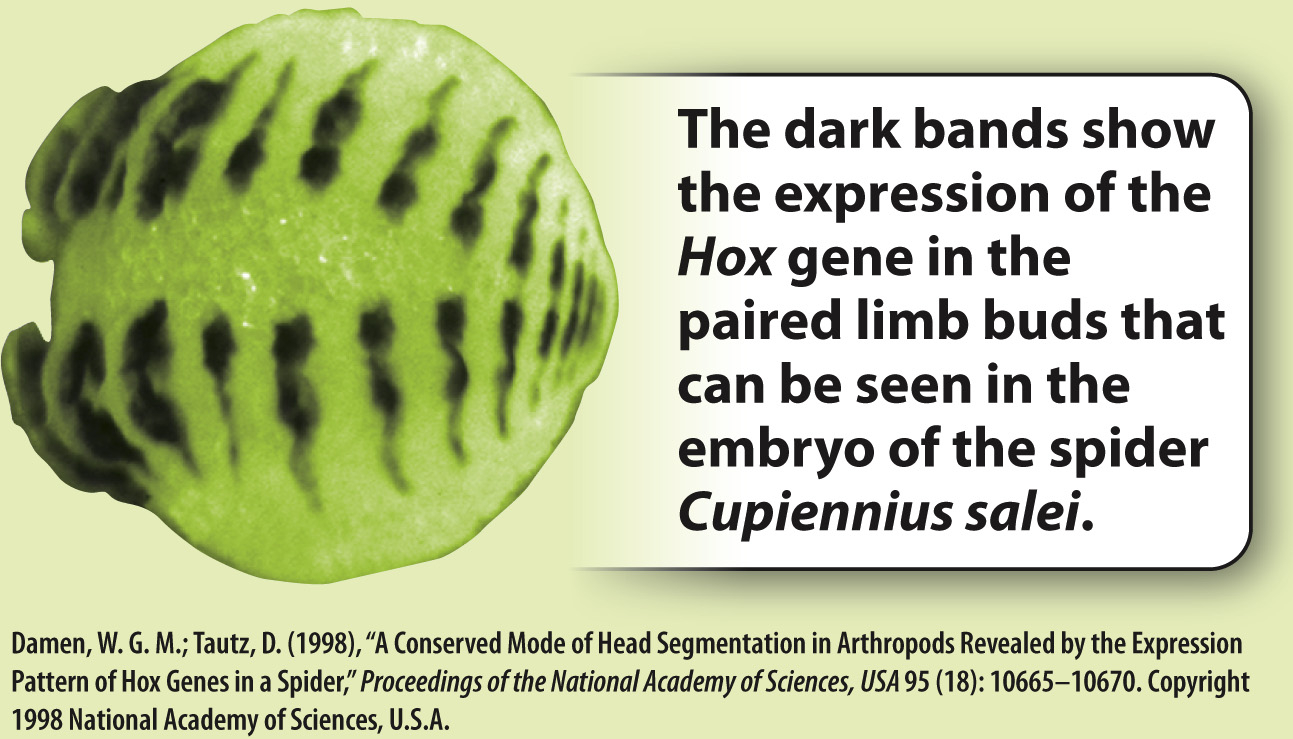
RESULTS Study of the embryos revealed that, for example, the jawlike mandibles of insects and crustaceans form from appendages on the same segments of the developing body, whereas this segment on spiders and scorpions bears a pair of leglike feelers. Behind the mandibles are two pairs of feelers that are represented by legs in spiders and scorpions. On the other hand, the fangs of spiders and their counterparts in scorpions arise from a segment closer to the front end than the mandibles.
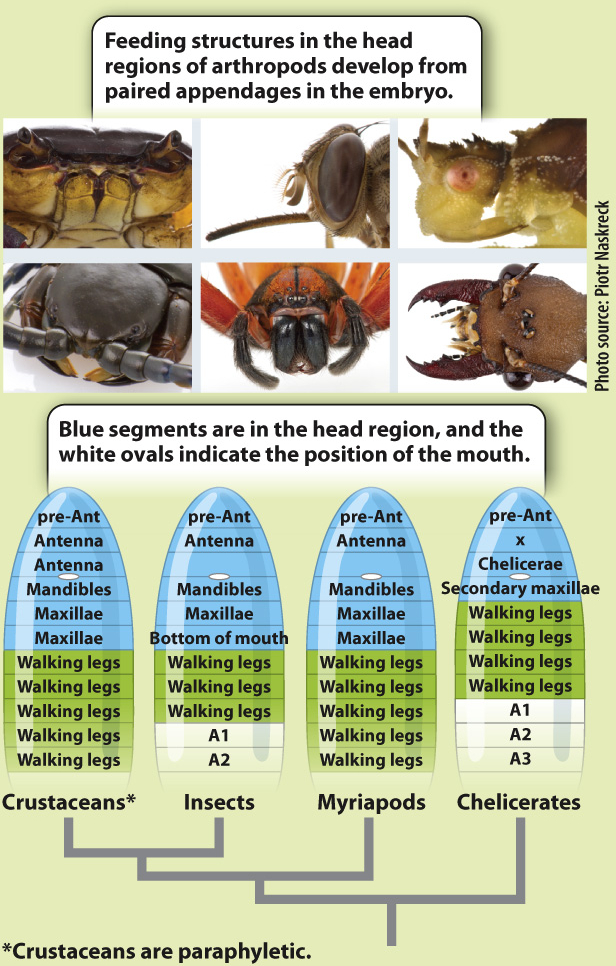
CONCLUSIONS The diverse feeding structures of arthropods arise from limb buds in the first segments of the developing embryo. The mandibles of crustaceans and insects arise from the same body segment and indicate the common ancestry of these animals, while spiders, scorpions, and their relatives are more distantly related. Evolution has modified simple legs into the remarkable diversity of forms, enabling structures as specialized as a spider’s fangs and the grinding mandibles of crabs.
FOLLOW-
SOURCE Damen, W. G. M., et al. 1998. “A Conserved Mode of Head Segmentation in Arthropod Revealed by the Expression Pattern of HOX Genes in a Spider.” Proceedings of the National Academy of Sciences USA 95:10665–
The arthropods’ other defining characteristic is the material that forms their hard external skeleton: a strong, lightweight and nearly indestructible polysaccharide called chitin. Chitin, you may recall from Chapter 34, also forms the wall of fungal cells. Next to the cellulose that forms the wall of plant cells, chitin may be the most abundant biomolecule on Earth.
There are four main groups of arthropods (Fig. 44.23), of which the most diverse by far are the insects. The other three are chelicerates, which include spiders, scorpions, and their relatives; myriapods, which include centipedes and millipedes; and crustaceans, which include lobsters, shrimp, crabs, and their relatives.
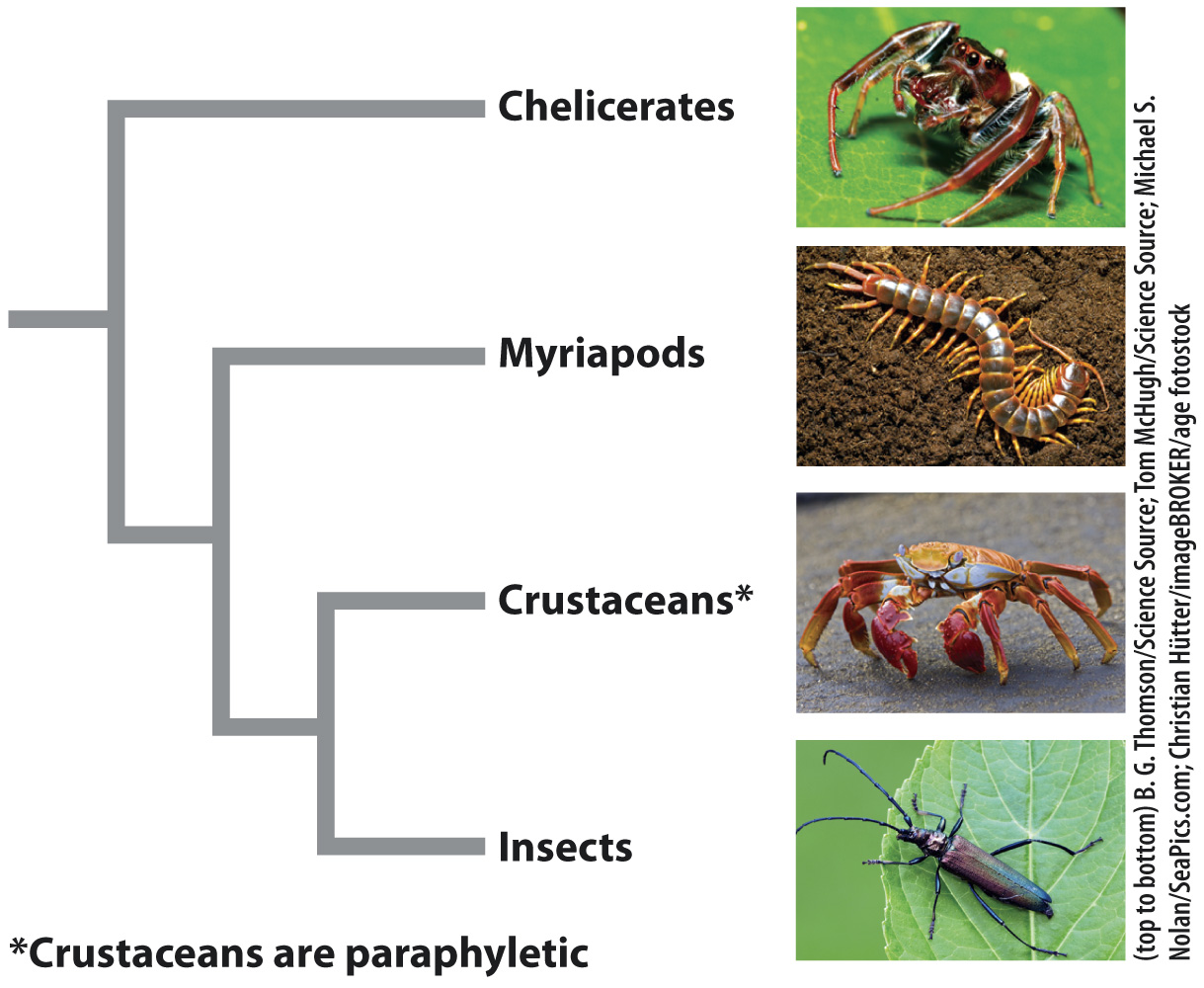
Chelicerates, named for the pincerlike claws called chelicerae, are the only arthropods that lack antennae. The chelicerates are mostly carnivores, except for plant-
Myriapods are named for their many pairs of legs, which make them easy to recognize. Centipedes (“hundred legs”) may have up to 300 pairs of legs and are fast-
Crustaceans also have distinctive appendages, notably their branched legs. They navigate their world with the aid of two pairs of highly sensory antennae, the larger of which has two branches. The unique crustacean larva, called a nauplius, swims with the aid of the smaller antenna and has a single eye that typically disappears in the adults. In the sea, these versatile arthropods fill many of the ecological roles that insects play on land, eating plants, other animals, or detritus. The tiny shrimplike plankton known as krill occur in vast numbers in polar seas, supporting ecosystems of fish, birds, and mammals such as whales. One Antarctic krill species is estimated to total over 500 million tons of biomass, more than the global total for humans. Lobsters and crabs are largely detritivores, scouring the ocean bottoms for dead and dying animals. Some crustaceans are even parasites, attaching themselves to the skin or inside the mouths of fish or sea mammals in order to feed. The strange creatures known as barnacles begin life resembling shrimp but soon settle on a surface for a life of filter-
Insects were the first animals—
Within the insects, the main evolutionary dividing line is between those that undergo metamorphosis, a major change in form from one developmental stage to another, and those such as grasshoppers and water bugs that do not. Insects that do not undergo metamorphosis look much like miniature adults when they hatch, and the main change in body form involves the appearance of wings. Some, like dragonflies, may also change the form of their legs or eyes as they leave the aquatic environment.
However, for those insects undergoing metamorphosis, the body changes from a wormlike larva specialized for feeding to a pupa (Fig. 44.24). During the pupa stage, the body tissues undergo a remarkable transformation from the relatively simple larva to a very different looking adult such as a fly, butterfly, wasp, or beetle, usually specialized for reproduction. Insects undergo a nearly complete dissolution of their muscles and other body parts, and so require the immobile, coffinlike pupa in which to transform their bodies from something as simple as a maggot, which lacks even an obvious head or tail, into an animal as sophisticated as a fly, able to walk on water, hover motionless in front of a flower, or fly at 60 mph. This evolutionary step has little parallel elsewhere in life and is one of the keys to insect diversification.
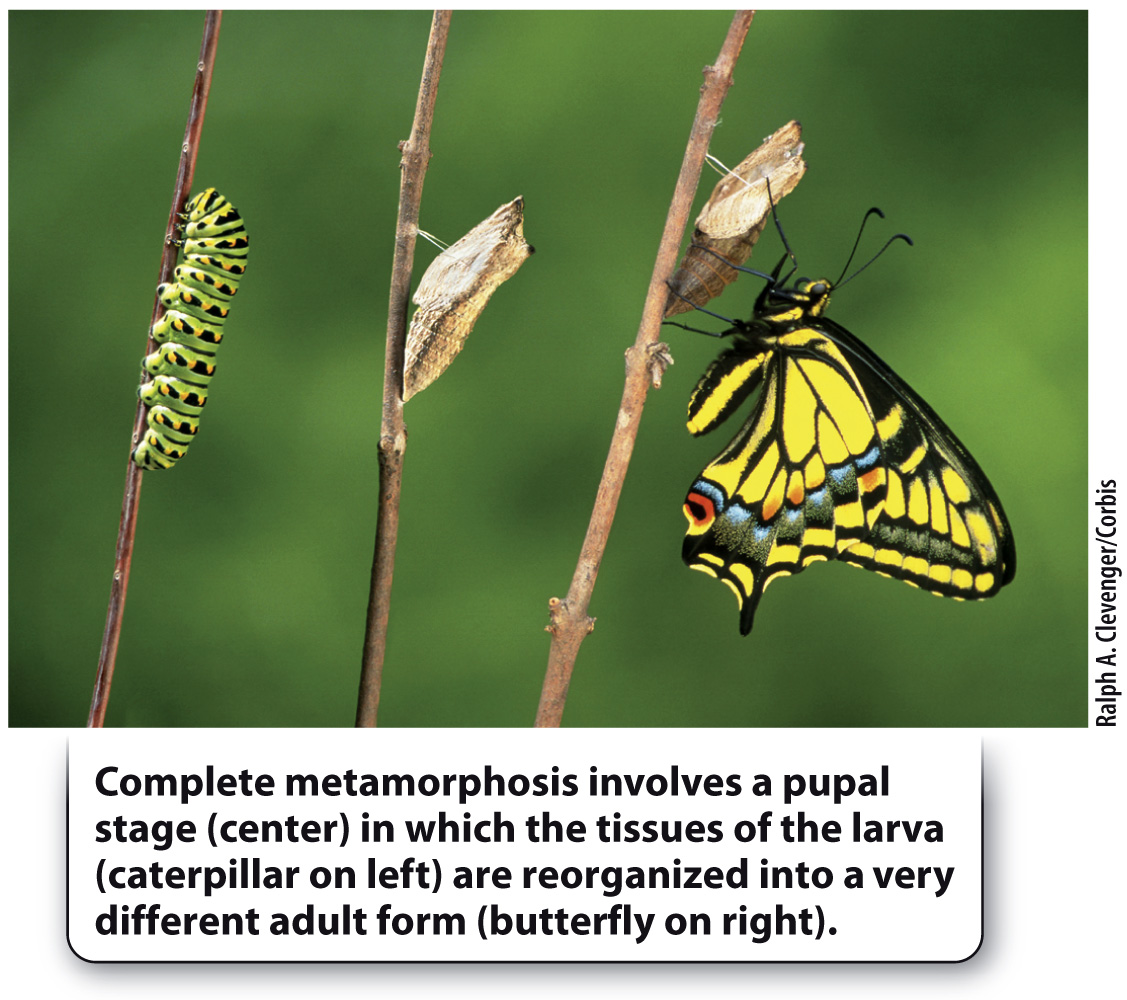
Unlike other terrestrial arthropods, all insects, whether or not they undergo metamorphosis, have highly specialized eggshells that can withstand desiccation while still allowing gas exchange. This shell allows insect eggs to survive in dry settings such as the surfaces of leaves, and so they can occupy habitats that are difficult for other terrestrial arthropods to access.
Insects have evolved one other critical adaptation for life on land. Aquatic arthropods obtain oxygen through gills, which don’t work well in air because their large surface area dries out. Some terrestrial chelicerates have evolved simple lungs, called book lungs: modified appendages filled with hemolymph that have a large surface area for gas exchange, but are kept moist inside a protective pocket. Some crabs are able to make extended forays on land by keeping their gills moist underneath their carapace. In contrast, insects exchange gases through small pores in their exoskeletons called spiracles (Chapter 39). The spiracles connect to an internal system of tubes, the tracheae, that directs oxygen to and removes carbon dioxide from respiring tissues, much like air exchange ducts in a building.
Insects are extraordinarily diverse, with approximately 1 million described species making up 80% or more of all known animal species. Their success may be a function of the three adaptations that allow them to live in diverse habitats: dessication-